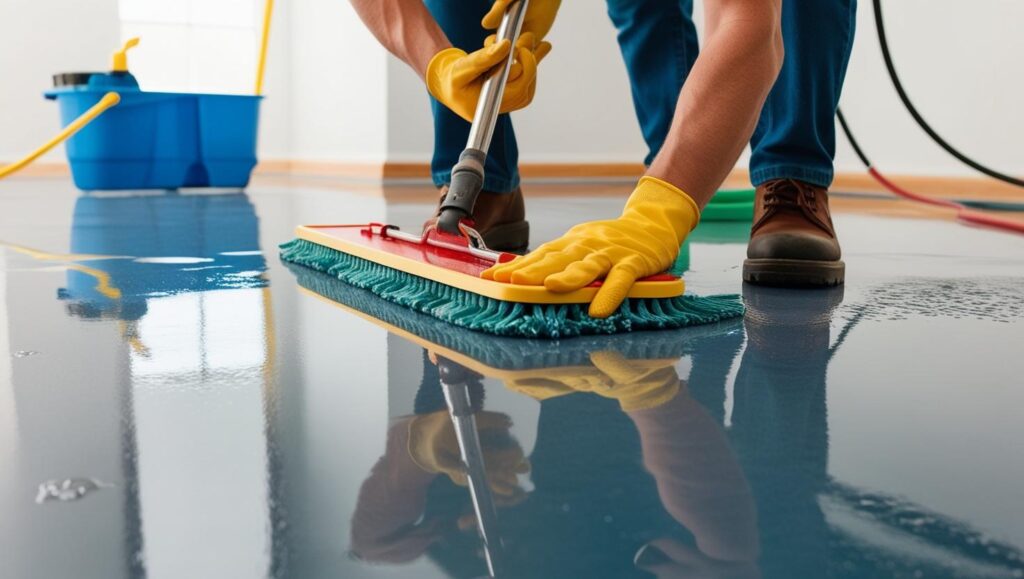Epoxy floor is popular for residential, commercial, and industrial spaces due to its durability, attractive appearance, and resistance to chemicals.
Whether you have an epoxy floor in your garage, basement, or living room, maintaining its appearance and longevity requires proper cleaning and care.
This guide will cover step-by-step processes about how to clean epoxy floors easily.
Let’s drive!
What Makes Epoxy Flooring Different?
Before diving into the cleaning process, it’s essential to understand the nature of epoxy floors. Epoxy flooring is created by applying a resin layer over a surface, typically concrete. This resin hardens to form a smooth, seamless, and high-gloss finish. Epoxy floors are visually appealing and highly resistant to wear and tear, which make them ideal for high-traffic areas.
However, like all surfaces, epoxy floors are susceptible to dirt, dust, and occasional spills, especially in busy spaces like garages or workshops. Regular cleaning and proper maintenance are the key to keeping them looking their best.
Why Is Epoxy Flooring Regular Cleaning Important?
Even though epoxy floors are durable, dirt and debris can dull the shiny surface over time if left uncleaned. So, Regular cleaning is need to:
- Preserving the Shine: Dirt and dust particles can scratch the epoxy surface, dulling its glossy finish.
- Preventing Stains: Spills, especially from chemicals like oil or paint, can stain the floor if not cleaned promptly.
- Increasing Lifespan: Regular cleaning can help the floor last longer and stay in excellent shape for many years.
How to Clean Epoxy Floor – [Step-by-Step Process]
Here is a simple, easy-to-follow guide for cleaning your epoxy floor. These steps will ensure your floor stays clean, shiny, and damage-free.
Step 1: Gather Your Cleaning Supplies
To clean your epoxy floor, you will need the following supplies:
- A soft-bristle broom or microfiber dust mop
- A bucket
- Warm water
- Mild dish soap or a pH-neutral floor cleaner
- A sponge mop or microfiber mop
- A soft cloth or towel
- A vacuum cleaner with a soft brush attachment (optional)
- Non-abrasive cleaning pads for more challenging spots
Step 2: Sweep or Vacuum the Floor
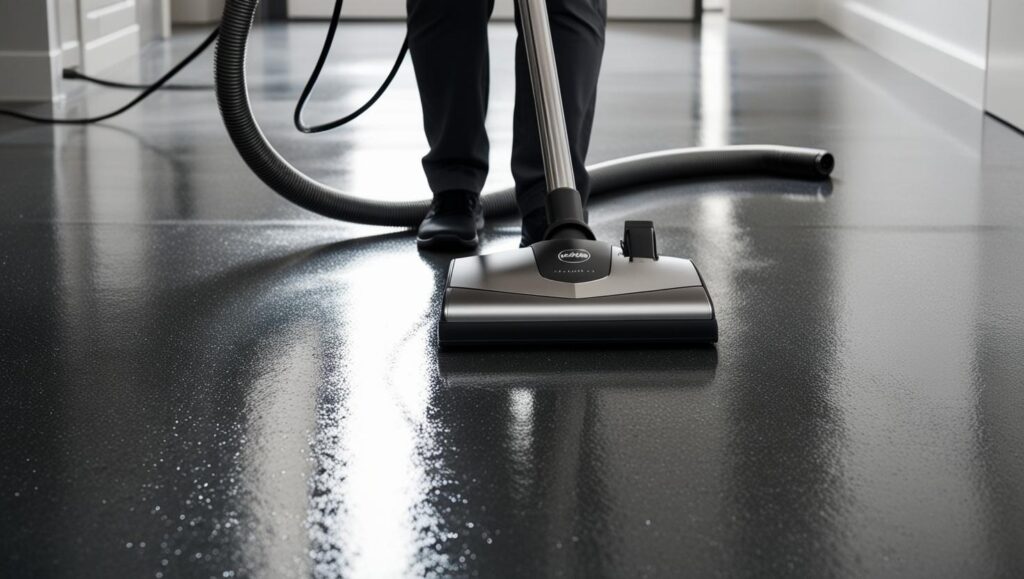
The first step in cleaning an epoxy floor is removing loose dirt, dust, and debris. Use a soft-bristle broom or a microfiber dust mop to sweep the floor gently. This step prevents scratches if dirt is left on the surface during mopping.
Alternatively, you can use a vacuum cleaner with a soft brush attachment to suck up dirt and dust, especially in hard-to-reach corners or along the edges.
Step 3: Use mild soap and warm water to mop
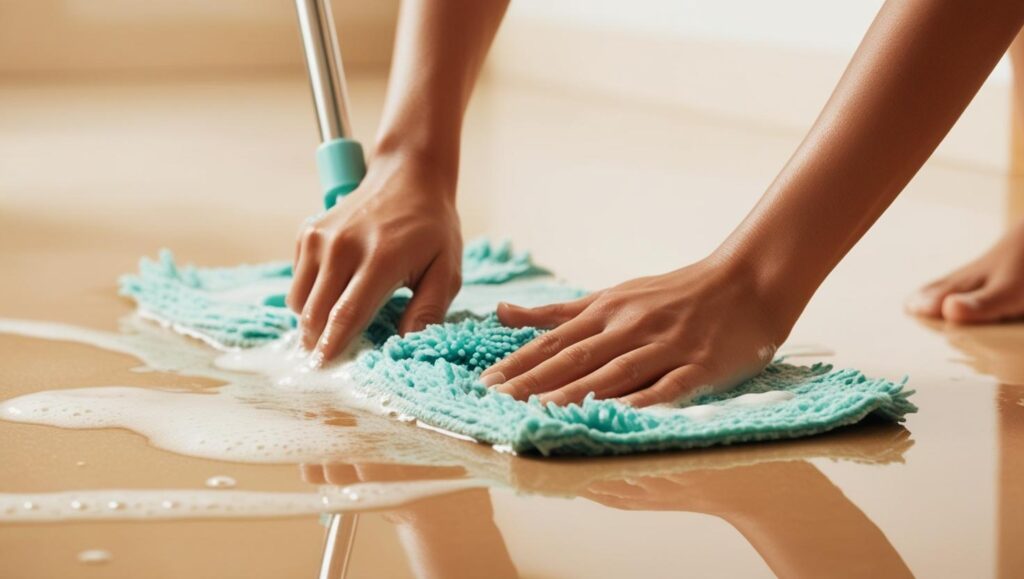
Once you’ve removed the dust and dirt, now mop the floor. Fill a bucket with warm water and add mild dish soap or a pH-neutral cleaner. Avoid harsh or acidic cleaning agents, such as ammonia or vinegar. They can damage the epoxy coating.
Dip a sponge or microfiber mop into the soapy water. To avoid too much moisture, wring it out. Mop the surface gently. Be sure to rinse the mop frequently in the bucket to avoid spreading dirt.
Step 4: Rinse the Floor
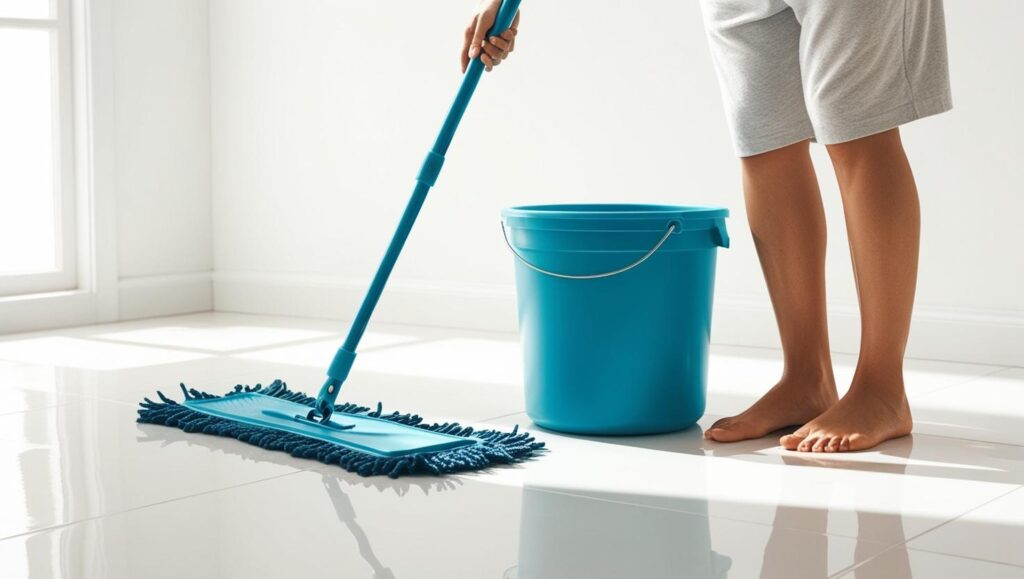
After mopping with soapy water, rinse the floor with warm water. This step is important to remove any soap residue, which can leave streaks or a dull finish on the epoxy. You can use the same mop, but make sure to thoroughly rinse it out before using it with clean water.
Once you’ve finished rinsing, use a dry, soft towel or cloth to wipe the floor and remove any excess moisture. This will help prevent water spots and maintain the floor’s glossy appearance.
Step 5: Tackle Stubborn Stains and Spots
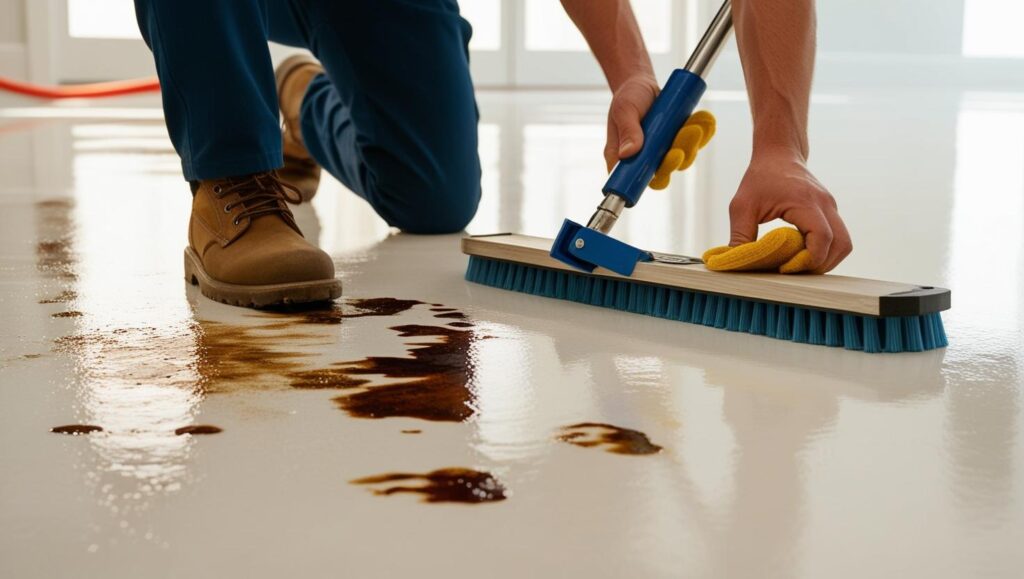
You’ll need more effort for tougher stains, such as oil, grease, or chemical spills. Here’s how you can tackle specific types of stains on epoxy floors:
- Oil and Grease: If oil or grease stains exist, use a degreaser specifically designed for epoxy floors. Apply the degreaser directly to the stain, let it sit for a few minutes, and then wipe it away with a clean cloth. Rinse the area with water afterward.
- Rust Stains: Rust stains can occur, especially in garages or industrial areas. To remove rust, mix a small amount of baking soda with water to form a paste. Apply the paste to the rust stain, sit for a few minutes, and gently scrub with a soft, non-abrasive cloth. Rinse the area thoroughly with water.
- Chemical Spills: If chemicals spill on your epoxy floor, cleaning them up immediately is essential to prevent damage. For most chemical spills, a simple soap and water solution will suffice. However, for more potent chemicals, consult the manufacturer’s cleaning recommendations.
Regular Maintenance Tips for Epoxy Floors
While occasional deep cleaning is necessary, regular maintenance can go a long way in keeping your epoxy floor looking like new. Here are a few maintenance tips:
- Sweep Daily or Weekly: Depending on how much traffic your floor gets, regular sweeping or vacuuming will prevent dirt and dust buildup.
- Mop Monthly: A monthly mopping with warm water and mild soap can help keep the floor’s shine intact.
- Use Floor Mats: Placing floor mats near entryways can help trap dirt and moisture, preventing it from being tracked onto the epoxy floor.
- Avoid Abrasive Cleaning Tools: Never use steel wool, harsh scrubbing pads, or any abrasive cleaners on your epoxy floor, as they can scratch the surface.
What to Avoid When Cleaning Epoxy Floors
To ensure the longevity of your epoxy floor, avoid the following when cleaning:
- Strong Acids or Alkaline Cleaners: Harsh chemicals like vinegar, ammonia, or bleach can weaken the epoxy coating over time.
- Scrubbing Pads or Brushes with Hard Bristles: Abrasive tools can scratch and dull the epoxy surface.
- Excessive Water: Avoid leaving standing water on the floor for extended periods, which can cause streaking and water spots.
Conclusion
Cleaning an epoxy floor is straightforward. When done regularly, you can maintain the floor’s durability and appearance for years. You can enjoy a sparkling, glossy floor that is resistant to stains and dirt and wear it properly. Following the steps about how to clean epoxy floor in this guide will keep your epoxy floor looking its best while ensuring its long-lasting performance.
Remember, the key to effective cleaning is consistency. Stick to a regular maintenance schedule, and your epoxy floor will continue to impress with its high-gloss finish and resilience.
Frequently Asked Questions
Can I use a steam cleaner on my epoxy floor?
Steam cleaners are generally not recommended for use on epoxy floors, as the high heat can potentially damage the epoxy coating. For best results, stick to mopping with warm water and mild soap.
How often should I clean my epoxy floor?
For high-traffic areas, such as garages or workshops, it’s a good idea to sweep or vacuum daily and mop once a month. For lower-traffic areas, sweeping once a week and cleaning every two to three months should suffice.
What should I do if my epoxy floor loses its shine?
If your epoxy floor looks dull, a professional polishing service can restore its shine. You can also apply a specialized epoxy floor polish, but ensure it’s compatible with your floor before use.


